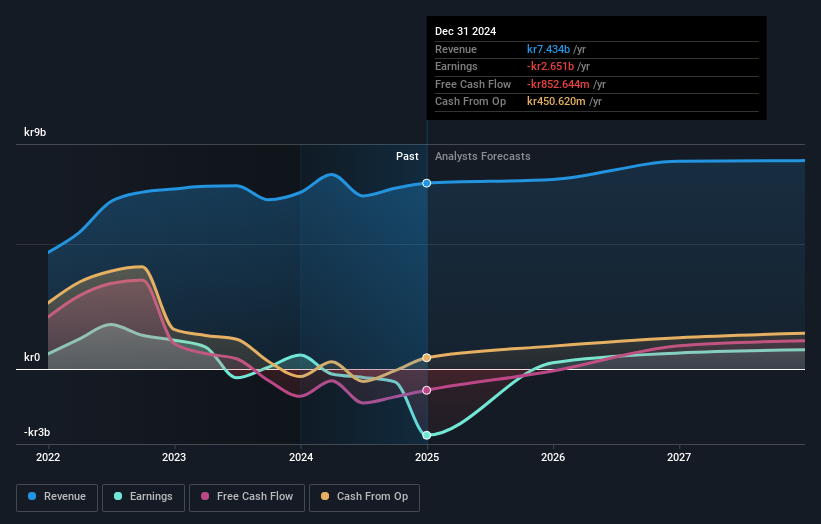Grieg Seafood ASA's (OB:GSF) market cap surged kr791m last week, private companies who have a lot riding on the company were rewarded

Key Insights
- Significant control over Grieg Seafood by private companies implies that the general public has more power to influence management and governance-related decisions
- Grieg Maturitas AS owns 51% of the company
- Insiders have been buying lately
To get a sense of who is truly in control of Grieg Seafood ASA (OB:GSF), it is important to understand the ownership structure of the business. The group holding the most number of shares in the company, around 60% to be precise, is private companies. Put another way, the group faces the maximum upside potential (or downside risk).
As a result, private companies were the biggest beneficiaries of last week’s 13% gain.
Let's delve deeper into each type of owner of Grieg Seafood, beginning with the chart below.
Check out our latest analysis for Grieg Seafood

What Does The Institutional Ownership Tell Us About Grieg Seafood?
Institutional investors commonly compare their own returns to the returns of a commonly followed index. So they generally do consider buying larger companies that are included in the relevant benchmark index.
As you can see, institutional investors have a fair amount of stake in Grieg Seafood. This can indicate that the company has a certain degree of credibility in the investment community. However, it is best to be wary of relying on the supposed validation that comes with institutional investors. They too, get it wrong sometimes. When multiple institutions own a stock, there's always a risk that they are in a 'crowded trade'. When such a trade goes wrong, multiple parties may compete to sell stock fast. This risk is higher in a company without a history of growth. You can see Grieg Seafood's historic earnings and revenue below, but keep in mind there's always more to the story.

Grieg Seafood is not owned by hedge funds. Grieg Maturitas AS is currently the company's largest shareholder with 51% of shares outstanding. This essentially means that they have extensive influence, if not outright control, over the future of the corporation. Om Holding AS is the second largest shareholder owning 5.5% of common stock, and The Vanguard Group, Inc. holds about 1.7% of the company stock.
While studying institutional ownership for a company can add value to your research, it is also a good practice to research analyst recommendations to get a deeper understand of a stock's expected performance. There are a reasonable number of analysts covering the stock, so it might be useful to find out their aggregate view on the future.
Insider Ownership Of Grieg Seafood
While the precise definition of an insider can be subjective, almost everyone considers board members to be insiders. Management ultimately answers to the board. However, it is not uncommon for managers to be executive board members, especially if they are a founder or the CEO.
I generally consider insider ownership to be a good thing. However, on some occasions it makes it more difficult for other shareholders to hold the board accountable for decisions.
Our information suggests that Grieg Seafood ASA insiders own under 1% of the company. We do note, however, it is possible insiders have an indirect interest through a private company or other corporate structure. It has a market capitalization of just kr7.1b, and the board has only kr3.5m worth of shares in their own names. Many tend to prefer to see a board with bigger shareholdings. A good next step might be to take a look at this free summary of insider buying and selling.
General Public Ownership
The general public, who are usually individual investors, hold a 25% stake in Grieg Seafood. While this group can't necessarily call the shots, it can certainly have a real influence on how the company is run.
Private Company Ownership
Our data indicates that Private Companies hold 60%, of the company's shares. It might be worth looking deeper into this. If related parties, such as insiders, have an interest in one of these private companies, that should be disclosed in the annual report. Private companies may also have a strategic interest in the company.
Next Steps:
I find it very interesting to look at who exactly owns a company. But to truly gain insight, we need to consider other information, too. Take risks for example - Grieg Seafood has 2 warning signs (and 1 which is potentially serious) we think you should know about.
If you would prefer discover what analysts are predicting in terms of future growth, do not miss this free report on analyst forecasts.
NB: Figures in this article are calculated using data from the last twelve months, which refer to the 12-month period ending on the last date of the month the financial statement is dated. This may not be consistent with full year annual report figures.
New: Manage All Your Stock Portfolios in One Place
We've created the ultimate portfolio companion for stock investors, and it's free.
• Connect an unlimited number of Portfolios and see your total in one currency
• Be alerted to new Warning Signs or Risks via email or mobile
• Track the Fair Value of your stocks
Have feedback on this article? Concerned about the content? Get in touch with us directly. Alternatively, email editorial-team (at) simplywallst.com.
This article by Simply Wall St is general in nature. We provide commentary based on historical data and analyst forecasts only using an unbiased methodology and our articles are not intended to be financial advice. It does not constitute a recommendation to buy or sell any stock, and does not take account of your objectives, or your financial situation. We aim to bring you long-term focused analysis driven by fundamental data. Note that our analysis may not factor in the latest price-sensitive company announcements or qualitative material. Simply Wall St has no position in any stocks mentioned.
About OB:GSF
Grieg Seafood
Through its subsidiaries, operates as a fish farming company in Norway, the United Kingdom, rest of Europe, the United States, Canada, Asia, and internationally.
Undervalued with reasonable growth potential.
Similar Companies
Market Insights
Community Narratives



